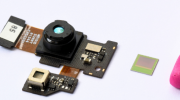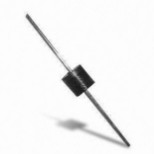The hall effect rotating position sensor USES a magnetic field instead of a mechanical brush or dial to measure the angular position of moving parts.This product USES magnetic bias hall effect integrated circuit (IC) to detect the rotating motion of the actuator shaft in the working range.The principle is that the rotation of the actuator shaft causes the position of the magnet relative to IC to change, and causes the flux density to change, and this change is finally converted into linear output.
This series of sensors adopt the solid state hall effect technology, which can be used for non-contact operation.The internal magnetic field of the sensor replaces the mechanical brush or contact brush in the potentiometer, which causes friction during operation and often reduces the service life of the device.Therefore, the non-contact magnetic hall effect technology adopted in this product series significantly reduces mechanical wear and actuator torque, thus extending the service life of the equipment.
Hall effect rotatory position sensors are cost effective for a variety of demanding applications in the transportation and industrial sectors.
Transportation applications
Pedal position transmission detection
In some heavy-duty or other types of vehicles, the hall effect rotatory position sensor can be used instead of the throttle cable.For example, the honeywell RTY series hall effect rotary position sensor can be mounted on the side of the pedal to measure how far the pedal is pushed.As the driver pushes harder on the pedal, it pushes harder, pumping more air and fuel into the engine and speeding up the car.When the driver releases the pedal, the hall effect rotation-position sensor senses the change in the pedal position and sends a signal to the engine to reduce the amount of air and gas flowing through the throttle, and the vehicle slows down.
Cables can cause problems such as overstretching or corrosion, potentially increasing the burden of maintenance and recalibration.Using sensors instead of cables will optimize the response of engine control systems, thereby reducing vehicle emissions, improving reliability, and preventing vehicles from being overweight.In general, electronic wire-operated systems are safer and more economical than older cable-connected systems.
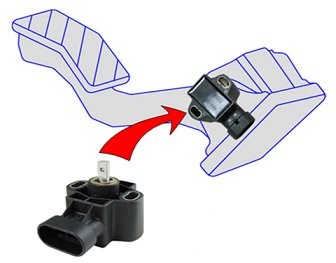
Honeywell RTY series rotary position sensor for pedal position sensing
Suspension displacement/kneeling position detection for passenger cars and trucks
The hall effect rotating position sensor can be used in the height system of passenger cars or heavy vehicles to sense the position change of the suspension system.The kneeling system of the passenger car can lower the position of its superstructure and make it convenient for passengers to get on the bus.The hall effect rotating position sensor can be used on both the operating and the executing ends of the system: one position sensor detects the position of the joystick, and a second sensor is deployed on the suspension arm or suspension arm connection to detect the vehicle height.
Precise position sensing ensures that the vehicle is at the height required by the application system, thus facilitating the loading and unloading of the vehicle.Large heavy-duty trailers can also use the hall effect rotation position sensor to detect the height of the trailer carriage to optimize the warehousing process.
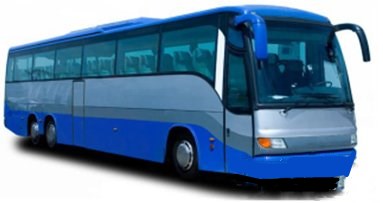
Rotating position sensor can be used for bus suspension system displacement sensing
Speed boat dip/draft position detection
Hall effect rotating position sensor can be used to detect the tilting/draught difference of the speedboat.This series of sensors can accurately report the angular position of the propeller, helping the driver avoid danger and improving the hull performance.

Hall effect rotation position sensor can be used for speed boat propeller tilt/draft difference position sensing
Industrial application
Irrigation control
Irrigation and spraying systems for large-scale agriculture are another novel application of the hall effect rotating position sensor.This series of sensors can detect the Angle range of the sprinkler during irrigation operations to confirm whether the sprinkler is being sprayed in a directional or 360-degree manner.This could help farmers reduce water consumption and increase crop yields.

Hall effect rotating position sensor can be used to detect the steering Angle of irrigation equipment
Valve position detection
This series of sensors can be widely used for valve control in industrial production and processing.Oil fields, nuclear power plants, food processing plants and beverage manufacturers all need to test the position of the valve. Hall effect rotating position sensor can be used to test the position of various large and small valves to help staff confirm the state of the valve and the size of the opening range.

Hall effect rotating position sensor can be used to detect valve position
HVAC baffle control
Heating, ventilation and air-conditioning systems can use rotating position sensors to help control the baffles.Open baffles can either bring cold air into the room or heat/cool air into the room with Windows open, both of which reduce system efficiency and increase heating/cooling costs.The combined use of rotary position sensors and temperature sensors can help building managers better control the HVAC system and effectively reduce operating costs.
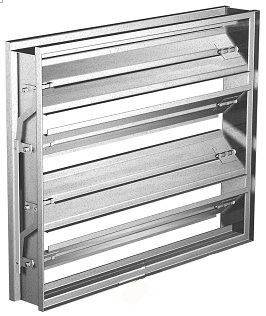
Hall effect rotating position sensor can be used to control HVAC baffle
What advantages should design engineers consider when selecting a hall effect rotating position sensor?
Reliability and long life: sensor integrated circuits, including regulation circuits, protection circuits and permanent magnets, shall be packaged in rugged packages up to protection grade IP67.This is essential for devices used in harsh environments.
Proven long life: honeywell's RTY series hall effect rotatory position sensor is designed to last 15 million cycles, thanks to its good bearing design and associated IC components.Honeywell has been tested 15 million times over the life of the product, eliminating the need for customers to test it themselves.
Integrated connector: the importance of integrated connector is reflected in two aspects: 1) smaller size: integrated connected sensor is smaller than the overall package size of the sensor dependent on the lead connection, so developers can design a smaller overall system package style;2) longer life: excessive stretching, wear and tear, biting or curling of the leads.The integrated connector sensor does not require a lead and is therefore more durable.
Anti-emi/emc: radio waves of different frequencies may interfere with electronic devices.Honeywell products adopt automotive EMI/EMC protection, which can effectively avoid electromagnetic interference during the use of the sensor.
Integrated reverse polarity protection: honeywell's RTY series integrates reverse polarity protection to prevent damage caused by installation errors (such as negative and positive polarity reverse connection that may cause short circuit).
Standardized input/output (IO) : industry standard AMP connector, 32mm mounting pitch, universal pin style, compact package simplifies the insertion and replacement process because the mounting pitch, profile, and pin style are compatible with existing equipment.
Multiple range of work: multiple range of work provides the design engineer with the range resolution required in common applications and can withstand certain out-of-range measuring operations.
Flexibility: with low voltage and high voltage models, covering the input voltage range of 4.5 Vdc to 30 Vdc, the practical application is more flexible.

 Inglês
Inglês  Chinês
Chinês  Alemão
Alemão  Coreano
Coreano  Japonês
Japonês  Farsi
Farsi  Portuguese
Portuguese  Russian
Russian  Espanhol
Espanhol 
